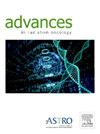优化基于锥形束计算机断层成像的在线适应性放射治疗的工作流程,以减少医生的介入
IF 2.7
Q3 ONCOLOGY
引用次数: 0
摘要
目的评价优化的在线适应性放射治疗工作流程对医师参与的影响。方法和材料对一项前瞻性2期试验的数据进行分析,该试验涉及34名前列腺癌患者,他们接受了基于锥束计算机断层扫描(CBCT)的在线适应性放射治疗(62 Gy,分20个部分)。工作流程中的2个步骤需要人工干预:放射治疗技术专家审查和调整自动分割的器官,指导目标分割,所谓的“影响者”,而医生审查和完善目标。比较了三种不同的工作流程:2影响者(直肠和膀胱)、3影响者(+前列腺)和5影响者(+精囊和肠道)。比较了工作流程步骤的时间、手动更正的范围和目标量更改。结果共分析了613个组分。5个影响者工作流将人工目标修正率降低到11%,而3个影响者工作流为51%,2个影响者工作流为61% (P < .001)。跨工作流的中位会话持续时间为24.0分钟(IQR, 22.0-28.0)。5位影响者工作流程的目标审查时间中位数最短,为2.5分钟,而3位影响者工作流程为5.0分钟(P < .001), 2位影响者工作流程为5.6分钟(P = .002)。大多数患者(84%)认为治疗时间可耐受。结论:这项针对前列腺癌患者的研究表明,优化的工作流程减少了医生参与在线CBCT引导的适应性放射治疗的需要。优化的工作流程可以促进更多的放射治疗技术驱动的方法,类似于标准的图像引导放射治疗。其他癌症的进一步研究,也关注临床终点,需要进一步改进CBCT引导的在线适应性放射治疗。本文章由计算机程序翻译,如有差异,请以英文原文为准。
Optimizing Workflow for Cone Beam Computed Tomography-Based Online Adaptive Radiation Therapy Toward Reduced Physician Involvement
Purpose
To evaluate the impact of an optimized online adaptive radiation therapy workflow on physician involvement.
Methods and Materials
Data from a prospective phase 2 trial involving 34 prostate cancer patients treated with cone beam computed tomography (CBCT)-based online adaptive radiation therapy (62 Gy in 20 fractions) were analyzed. Manual interventions were required for 2 steps in the workflow: radiation therapy technologist review and adjustment of automatically segmented organs, guiding target segmentation, so-called “influencer,” while physicians reviewed and refined the targets. Three different workflows were compared: 2-influencer (rectum and bladder), 3-influencer (+prostate), and 5-influencer (+seminal vesicles and bowel). Time for workflow steps, extent of manual corrections, and target volume changes were compared.
Results
A total of 613 fractions were analyzed. The 5-influencer workflow reduced manual target corrections to 11% of fractions compared with 51% for the 3-influencer workflow and 61% for the 2-influencer workflow (P < .001). Median session duration across workflows was 24.0 minutes (IQR, 22.0-28.0). Median target review times were shortest with the 5-influencer workflow at 2.5 minutes compared with 5.0 minutes for the 3-influencer workflow (P < .001) and 5.6 minutes for the 2-influencer workflow (P = .002). Most patients (84%) found the treatment time well tolerable.
Conclusions
This study of prostate cancer patients suggests that optimized workflow reduces the need for physician involvement in online CBCT guided adaptive radiation therapy. Optimized workflows may facilitate a more radiation therapy technologist-driven approach similar to standard image guided radiation therapy. Further studies in other cancers, also focusing on clinical endpoints, are needed to further improve CBCT guided online adaptive radiation therapy.
求助全文
通过发布文献求助,成功后即可免费获取论文全文。
去求助
来源期刊

Advances in Radiation Oncology
Medicine-Radiology, Nuclear Medicine and Imaging
CiteScore
4.60
自引率
4.30%
发文量
208
审稿时长
98 days
期刊介绍:
The purpose of Advances is to provide information for clinicians who use radiation therapy by publishing: Clinical trial reports and reanalyses. Basic science original reports. Manuscripts examining health services research, comparative and cost effectiveness research, and systematic reviews. Case reports documenting unusual problems and solutions. High quality multi and single institutional series, as well as other novel retrospective hypothesis generating series. Timely critical reviews on important topics in radiation oncology, such as side effects. Articles reporting the natural history of disease and patterns of failure, particularly as they relate to treatment volume delineation. Articles on safety and quality in radiation therapy. Essays on clinical experience. Articles on practice transformation in radiation oncology, in particular: Aspects of health policy that may impact the future practice of radiation oncology. How information technology, such as data analytics and systems innovations, will change radiation oncology practice. Articles on imaging as they relate to radiation therapy treatment.
 求助内容:
求助内容: 应助结果提醒方式:
应助结果提醒方式:


